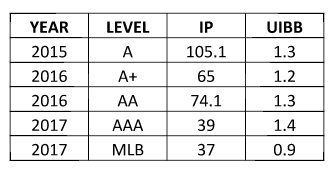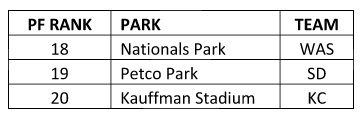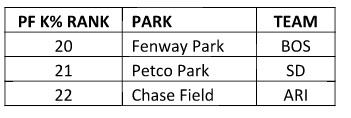Risers and Fallers: Volume 7
![]()
I’m excited to be back for another week of Risers & Fallers! Each week, I’ll break down a handful of players using advanced metrics, insights from my scouting background, and my DFS projection system THE BAT (available in the RotoGrinders Marketplace), which consistently beat Vegas lines last year.
I’ll examine guys whose stock is going up, guys whose stock is going down, guys who are perpetually underpriced or overpriced, guys who are worth paying a premium for, or guys who are just interesting and warrant some analysis on. If you guys have any suggestions for who you’d like to see in future articles, feel free to let me know.
Rising… Somewhat Fraudulently
Dinelson Lamet, SP, San Diego Padres
Debuting barely more than a month ago, Lamet (optimally pronounced with a French tongue, as per Dave Potts) has quickly become a favorite of quick-trigger DFS players. Despite facing a low-strikeout Braves offense, Lamet was 40%-owned in DraftKings cash games in his last start… but maybe 5% owned by sharks, who opted instead for David Price. Sure, Lamet turned in a great game, and I can’t speak for everyone who faded Lamet, but for me it wasn’t a close call and I’d make the same choice given the chance to do it again.

For the reasons people like Lamet, I like him too. He has electric stuff with a mid-90s fastball and a wipeout slider. His strikeout rates were huge in the minors, and they’ve gotten even better at the major league level. Some regression is coming for it, but I expect Lamet to remain a great bet for strikeouts on a per-batter basis. But there’s more to pitching than just strikeouts, and so my love for Lamet stops there.
This season has witnessed an influx of pitchers like Lamet with good stuff and a track record of high strikeout rates but who struggle with the other aspects of pitching. Guys who generate Ks but who also either walk hitters, give up flyballs and home runs, or both. Lamet. Jacob Faria. Brad Peacock. Buck Farmer. Francis Martes. Mike Clevinger. The list goes on.
Lamet has had home run issues since his promotion, posting just a 36% GB% and 1.95 HR/9. The homers will come down a bit (but still be a problem) as his walks inevitably come up. His 2.7 BB/9 is the lowest of his career at any level. Here are his career walk rates by year and level (minimum 30 IP), scaled to a 1.00 league average (over 1.00 meaning more walks than average, under 1.00 meaning fewer walks than average):

I shouldn’t need to point out which one is the outlier, particularly when you realize that the MLB level is the most difficult and that all of his previous walk rates would have been higher had he been facing MLB-caliber hitters. Conclusion: those walks are coming way up.
People seem to forgive Lamet for these issues because of the strikeouts and the perceived pitchers’ park he calls home: Petco Park. The problem with this line of reasoning is that Petco is not actually an extreme pitchers’ park anymore. It was a few years ago, but it has shifted over the past couple seasons. We can’t say exactly why (some have speculated that it’s a combined result of the fences being moved in for 2013, the addition of a giant video board in 2015, and the erection of the 16-story Sempra Energy building behind center field in 2015, the latter two perhaps altering wind patterns inside the park), only that the numbers are there and are well past the point of statistical significance. Here is a snippet of THE BAT’s current park factor rankings:

The 15th park is roughly the most neutral, which means that Petco is still on the pitching side, but not at the extreme end the way it used to be. Here’s how it ranks in terms of park factor strikeouts:

While Petco used to be elite when it came to inflating strikeouts, it no longer is. In fact, it actually deflates strikeouts a bit at this point, hanging out with hitters’ park like Fenway and Chase in that regard. That makes Lamet’s strikeouts to this point slightly more impressive, but it also means that match-ups in Petco aren’t actually the dream they used to be.
My biggest issue with Lamet, however, has nothing to do with his control. It has nothing to do with his home run issues. It has nothing to do with his home park. It has to do with his inability to go deep into games. I’m sure all of those who played him against the Braves will note that he went seven strong innings, but that was a season high for him. It also tied his minor-league high of seven innings—which he has managed to achieve one single solitary time since he began his career in Rookie ball in 2014. Lamet managed to go seven against the Braves because he was on the very good side of variance in allowing just four hits and one walk, managing to keep his pitch count low enough to get through seven. But that’s an outlying performance. That is nowhere near the norm for Lamet.
One of the newest features of THE BAT is that it now displays pitch count information for pitchers. When THE BAT projects a pitchers’ innings, it first projects the number of pitches a starter throws in a normal start—a start where he doesn’t dominate and doesn’t get lit up. This baseline pitch count is then adjusted based on the day’s matchup and how efficient the pitcher is projected to be and the kinds of outcomes he’s projected to produce (walks, for instance, severely drive up pitch counts). It’s capped by the maximum number of pitches the hurler has been allowed to throw over the past two seasons:

(bPC is Baseline, pPC is Projected, mPC is Max)
Lamet has one of the lowest baseline pitch counts of any starter in baseball, and if you look at his game logs, it’s easy to see why. He’s topped 90 pitches in just three of his seven MLB starts (never cracking triple-digits), and he averaged just 84 pitches across eight minor league starts before his call-up. In 2016, he averaged 85.5 pitches per start, and pitchers generally throw more pitches in minor league starts than they do after getting called up to the majors.
THE BAT’s baseline pitch count for Lamet is 85. Alex Wood, who despite being elite has a notoriously short leash, has a baseline pitch count of 92. A standard ace like Chris Archer has 108, while a mediocre veteran like Adam Wainwright has 96. Lamet is one of the lowest in baseball, and in a game where quantity matters (it’s why we don’t roster Aroldis Chapman), the inability to go as deep as 90%+ of the game’s other starting pitchers is a huge issue. Sure, it’s possible to have a start like his Atlanta one, but everything has to go exactly right to get to that point (remember, that was just the second start of his entire professional career pitching into the seventh inning). On a normal day, Lamet is more likely to go five innings, and for a guy who isn’t an elite talent in the way Wood is, Lamet just doesn’t stack up against the other options most days he pitches even if he projects well on a per-inning basis. How can he when the top options each day throw more pitches and project for 6 or 7 or 8 innings?
If you want to take a chance in a GPP that he has a start like he did in Atlanta, one where he hits on the good side of run-prevention variance and racks up the Ks, go right ahead, especially while he costs just $7,000 or so on DraftKings. But be wary as his price tag goes up, because it’s highly unlikely he’ll ever get you those really big points that come from having the chance to go complete until they loosen the reigns. And in cash games, unless the matchup is just right, he simply doesn’t have enough value to be a good play when he’s only being projected for 90 or so pitches. That’s not to say he won’t occasionally meet value, but on the whole he will be a suboptimal play. The next time it’s Dinelson Lamet chalk day, feel free to fade him.

Rising Some More
Sonny Gray, SP, Oakland A’s
I talked a couple weeks ago about how Sonny Gray is sneakily becoming one of the better pitchers in baseball. I mentioned that over the years, his stats have been deflated due to things like unduly strong quality of opposing offenses, a strikeout-suppressing park, and bad pitch-framing catchers. Well, the Oakland A’s fixed one of these problems recently by releasing catcher Stephen Vogt. That clears room on the roster for Bruce Maxwell, who has actually seemed to claim the starting the job. While Vogt was a below-average framing catcher, Maxwell is a borderline-good one. That’s a big upgrade for Gray and should only make him more valuable going forward, especially while he remains underpriced in the $8,000 range on DraftKings.